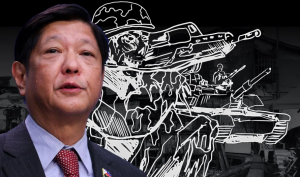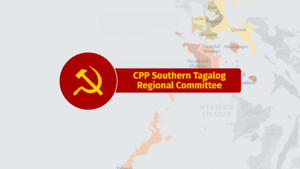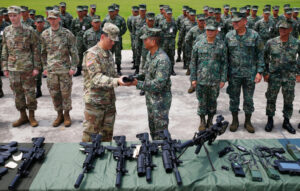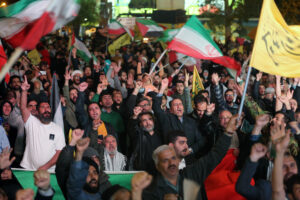US provocations against China bring the world closer to the brink of war
The recent official visit to Taiwan by US Speaker Nancy Pelosi, who arrived with a military airplane escort, was a brazen provocation against China. The visit comes on the heels of recent declarations by US President Biden that it will “come to Taiwan’s defense.” A few days earlier, Defense Sec. Mark Esper led an Atlantic Council delegation to Taiwan and called for an end to the “One China Policy” while an American warship, the USS Benfold, a guided-missile destroyer, sailed through the Taiwan Strait. The US military also deployed earlier four other US warships (USS Reagan carrier strike group, the USS Tripoli, USS Antietam and USS Higgins) east of Taiwan.
These displays of utter contempt of China’s assertion of sovereignty on Taiwan raise the already high temperature US and China inter-imperialist conflict. As US strategists anticipated, China responded to the provocations by firing missiles and conducting war exercises in the Taiwan Strait. The US wants China to make a miscalculation in the hopes that this will justify US actions to “defend Taiwan,” spur increased deployment and sales of US firepower in the region.
The Filipino people must condemn US imperialism for its continuing provocations against imperialist rival China, which bring Asia and the rest of the world closer to the brink of a wider inter-imperialist armed conflict. At the same time, they must denounce Chinese imperialism for its high-handed push to use military might, forsaking Mao Zedong’s long-standing policy of peaceful settlement, in resolving the issue of China’s reunification.
The imperialist US carries out these provocations against China even as it continues to engage in a proxy war in Ukraine against Russia. It reminds us of how the US government and the NATO ceaselessly provoked Russia by expanding the military alliance up to latter’s western borders.
Short historical background
The US imperialists have long used Taiwan as a pawn for its hegemonism in Asia and in its economic and military engagement with China. For close to 75 years now, the US used Taiwan as an economic and military stronghold to advance its strategic geopolitical interests in the Asia-Pacific region. The US considers Taiwan as part of its “First Island Chain” strategy of containing the rise and expansion of China as an imperialist rival. It has been actively funding and pushing groups in Taiwan to demand independence to weaken China’s claims. It has been pouring funds to build up Taiwan’s military strength.
Taiwan, whose population is close to 85% Han Chinese, has been part of China since the late 17th century. The Qing dynasty drove away the Dutch and Spanish colonial powers who took parts of the islands occupied by indigenous peoples subjugated by the Chinese Ming empire.
Throughout the 18th and 19th century, Taiwan was an integral part of China. It was, however, colonized by the rising imperialist Japan in 1895, which occupied the islands until 1945 when it ceded the territory in the aftermath of World War II. That year, the Chinese government, then under Chiang Kai Shek and the Kuomintang, accepted Japan’s surrender of Taiwan.
A civil war ensued in China from 1945 to 1949 between the US-suported Chiang government and the revolutionary forces led by the Communist Party of China (CPC). The CPC declared nationwide victory on October 1, 1949 and established the People’s Democratic Republic of China (PRC). On December 1949, the defeated Kuomintang forces left the mainland and retreated to the Taiwan province with the country’s gold and two million people, where they established China’s “wartime capital” and declared the aim of waging war to “retake” the mainland.
Like what it did in Vietnam and Korea, the US deployed its forces and extended political and military support to the local reactionaries to fight the revolutionary forces. It invaded Korea to fight the revolutionary forces, succeeded in dividing Korea into the North and South, and perpetuated this division by establishing military bases in South Korea. It initially succeeded in dividing Vietnam by supporting a series of puppet regimes in the south and by deploying hundreds of thousands of counter-guerrilla troops. The US imperialist forces were roundly defeated and driven home, paving the way for the unification of Vietnam as a single country.
In 1949, the US deployed its 7th Fleet to the Taiwan strait purportedly “to prevent hostilities,” which in reality, was a war of intervention in China. The US imperialists sought to prevent the PRC from pursuing and completely subduing the defeated Chiang Kai Shek, at the same time, extended political, military and economic support to the Kuomintang in Taiwan. It established a government that claims to represent the entire China, but which could only effectively rule the province of Taiwan. The Kuomintang, with the support of the US, imposed military rule for 38 years (1949-1979). From the outset, it carried out a vicious war of suppression against communists and patriots in Taiwan where close to 150,000 people were imprisoned or killed.
To secure the Kuomintang, the US provided Taiwan with missile batteries, which were set up along the Taiwanese strait. In 1954, the US signed a Mutual Defense Treaty with Taiwan, established the United States Taiwan Defense Command, and for 25 years, stationed around 30,000 American troops on the island.
In the 1950s, China was going through a period of rapid economic expansion or productive growth following the completion of land reform in 1954 under the leadership of the CPC and Mao Zedong. On the basis of the successes of land reform and the mass mobilization of the Chinese people, China began rapid industrialization from the late 1950s, and subsequently carried out socialist transformation of industry and agriculture.
In the face of the successes of the Chinese socialist revolution, US imperialism was compelled to allow capitalist development in Taiwan. The World Bank allowed Taiwan (as well as South Korea) to carry out land reform. The US (together with Japan) invested heavily in Taiwan in electrical and electronics assembly, manufacturing and financial services, and provided it with trade favors. During the 1950s, up to 30% of total domestic investment in Taiwan came directly from US economic aid. As a result, despite Taiwan’s small population, limited natural resources and dependence on imports, the local bourgeoisie accumulated large amounts of capital from annual trade surpluses which were reinvested to develop its own industries. From 1981 to 1986, up to 74% of Taiwan’s economic growth are linked to exports to the US market.
The US and other imperialists also extended the same pattern of investments and trade favors given to Taiwan to South Korea, Hong Kong and Singapore. These so-called “Asian Tigers” were artificially created, primarily by the US and Japanese imperialists, to make these territories serve as counterpoint to the economic and social progress in China from the 1950s onwards.
Normalization
Following the 1972 summit of Richard Nixon and Mao Zedong, US-China ties underwent “normalization” under the “one-China policy” where the US recognized the PRC as the sole government of China. In the Shanghai Communiqué, the US declared that it “acknowledges that all Chinese on either side of the Taiwan Strait maintain there is but one China and that Taiwan is a part of China.” The US also said that it does not challenge this view, and affirmed that it favors “peaceful settlement of the Taiwan question by the Chinese people from both the mainland and Taiwanese island.”
It will take seven more years before the US withdrew its troops in Taiwan, coinciding with the expiration of the US-Taiwan Mutual Defense Treaty. It would, however, pass the Taiwan Relations Law on the same year, under which, it established de facto diplomatic relations and extended military support to Taiwan.
In 1977, the Communist Party of China was taken over by the modern revisionists and led China to the path of capitalist restoration. The Chinese big bourgeoisie collaborated with the US imperialists to dismantle the socialist system, allow foreign private capital to invest and exploit cheap labor in China.
Economic relations and trade between the Chinese mainland and Taiwan increased. Capitalist investments from Taiwan was allowed in the mainland, including the Foxconn Company and the TSMC (Taiwan Semiconductor Manufacturing Company), two of the world’s biggest electronic assemblers and manufacturers. Since joining the World Trade Organization in 2001, China has served as the world’s biggest assembly line factory, pressing down workers’ wages to one of the lowest levels to absorb foreign capital at record rates. The big bourgeoisie in China has retained the façade of the communist party which allows them to accumulate private capital from state resources and state privileges.
The big bourgeoisie in mainland China and Taiwan mutually benefited from the restoration of capitalism in China. Both mainland China and Taiwan established liaison offices for regular exchanges. The matter of the reunification of China was set aside as a future “inevitable” which they sought to settle amicably.
Taiwan and the US pivot to Asia
From the 1990s to the 2000s, the US welcomed the integration of the former Soviet Union and China—now under the big state monopoly bourgeoise—into the global capitalist system. For years, the US imperialists considered China as a partner under the neoliberal policy regime, giving it a “most favored nation” status in trade. American companies outsourced manufacturing to China, taking advantage of the vast army of cheap labor to produce IPhones and other American-brand products.
The large-scale outsourcing would later backfire on the US economy and contribute to its strategic decline. The US economy produced less value, became increasingly financialized and more vulnerable to periodic crisis or the bursting of financial bubbles (real estate, dotcom, housing). Since the 2008 financial crisis, the US and the global capitalist system have floundered through protracted stagnation, causing rising inter-imperialist competition and heightening conflicts. As a result, successive US governments have become increasingly vocal against China, demanding the dismantling of statecontrolled enterprises, and measures to end the perennial US deficit in foreign trade with China. The US imperialists declared its “pivot to Asia” with a clear view against China as a strategic threat to its dominance. Since then, US policy has become increasingly aggressive and bellicose.
The US started to impose trade sanctions against China-made products, including against Huawei on the pretext that the company was engaged in spying for the Chinese government. It has also imposed sanctions against the export to China of advanced equipment for the production of modern semiconductors. On the military side, the US has activated the Quad security alliance (US, Japan, India and Australia) with the aim of encircling China. It is also pushing to further expand the North Atlantic Treaty Organization (NATO) beyond the Atlantic by including Japan, South Korea, Australia and New Zealand in its last summit in Madrid and having it declared China as a “strategic threat” to the military alliance.
The US imperialists see its position in Taiwan as a key element in its geopolitical strategy and conflict with China. Thus, it continues to strengthen its military alliance with Taiwan. Since 2019, Taiwan has ordered $17 billion worth of military equipment from the US. In less than two years, the Biden government has already made three arms sale to Taiwan. It was also revealed last year that American troops were training with the Taiwanese military. The US has been repeatedly carrying out provocative military operations in Taiwan, including increased “freedom of navigation” operations in and around the Taiwan Strait, as well as in the South China Sea.
Oppose US warmongering, China militarism
The US imperialists have a long history of using trade and economic sanctions and military pressure against its rival imperialist powers to provoke wars. In the face of prolonged stagnation and rising fears of falling into recession, the US is creating conditions of war to benefit its military industrial complex in a desperate bid to invigorate its economy.
The US proxy war in Ukraine against Russia has seen the soaring of profits of such companies as Raytheon, Lockheed-Martin and others which produce the missiles, drones and other equipment being exported to the war front. Heightening US warmongering is putting the entire world at risk.
The Filipino proletariat and people must stand with the rest of the world in opposing US war provocations in Asia and elsewhere. Revolutionary proletarian forces across all countries must consolidate, build or strengthen the communist vanguard party, lead the masses and develop their class political power by waging revolutionary armed resistance and all forms of struggle.
The broad masses of the Filipino people must also denounce the US military for using its military facilities in the Philippines and its territorial waters as springboard for aggressive acts around Taiwan and against China. These violate Philippine sovereignty and puts the country at risk of getting embroiled in the war of giants.
They must support the people of Taiwan as they militantly rise up against the use of Taiwan as a US pawn, condemn US interference in China’s domestic affairs, denounce China’s militarism, and push the Chinese people’s aspiration to resolve peacefully and amicably the matter of China’s reunification.
The Filipino people must also assert the country’s sovereignty against US military intervention. They must demand the abrogation of the Mutual Defense Treaty, the Visiting Forces Agreement and other one-sided military agreements. They must push for the dismantling of exclusive US military facilities in various AFP camps, and demand the withdrawal of all American troops and military advisers from Philippine soil, which makes the country a target of reprisals of US enemies.
The Filipino people must also call on China to respect Philippine national sovereignty and maritime territory and demand that China dismantle all military facilities built within and around the West Philippine Sea. China must be pushed to respect the 2016 decision of the International Arbitral Tribunal which recognized Philippine territorial waters, exclusive economic zone and extended continental shelf under the UNCLOS. China must stop industrial fishing and plunder of marine resources in these waters.
The broad masses of the Filipino people must also link arms with the workers and oppressed people of the United States and China and build a united front against imperialist war. The peace-loving people of the US and China are indignant over the increasing amount of funds being spent on weapons production and sales, while millions upon millions of people suffer from high prices, massive unemployment and the deterioration of social services for health, education, transportation and so on.
The Filipino people, together with the peoples of Indonesia, Malaysia, Singapore, Vietnam, Thailand, Korea, Japan and other countries in Asia and beyond must also build a united front to oppose imperialist aggression, especially US war provocations in the region. They must demand their governments to resist the pressure to be imperialist pawns. Together, and independently, the oppressed peoples around the world must press on their fight for genuine democracy, national freedom and socialism, in order to put an end to imperialism and its insatiable craving for war.










